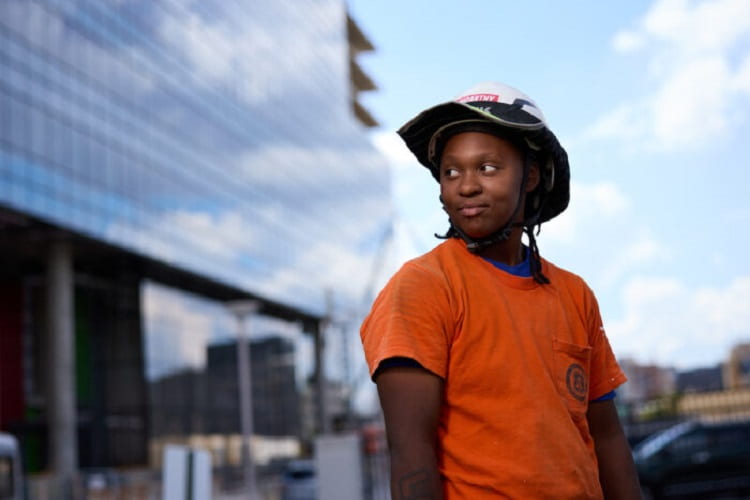Woven into the design of the Neuroscience Research Building under construction on the Washington University Medical Campus is an intangible yet still very real pillar deemed as important as the 6,500 truckloads of concrete used to reinforce the high-rise.
The pillar is a holistic philosophy of diversity, equity and inclusion integrated throughout the planning and construction of the 11-story, 609,000-square-foot building at 4370 Duncan Avenue. When it’s completed next summer, the structure will house one of the nation’s largest and most significant neuroscience research buildings, equipped with cutting-edge technology and the brainpower and creativity needed to nurture and advance groundbreaking research into the brain and the body’s nervous system.
“Without diversity, it’s impossible to deliver a state-of-the-art building,” said Melissa Rockwell-Hopkins, associate vice chancellor and associate dean of operations & facilities management at Washington University School of Medicine in St. Louis. “There’s diversity in skill, diversity in backgrounds, diversity in race and ethnicity, diversity in gender, diversity in all things big and small. All of it is critical to transforming the building into a steward of scientific innovation and advancement and creating positive growth on the Medical Campus and within the St. Louis community.”
To that end, construction of the Neuroscience Research Building has emphasized equality, employee development and community engagement. “First and foremost, all members of our team are considered equals, with no exceptions,” Rockwell-Hopkins said. “We are all doing important work.”
Rockwell-Hopkins strives to lead her department by example. She is the university’s first female associate vice chancellor to oversee billions of dollars in construction projects, including the $616 million neuroscience building, considered one of the most critical facilities projects in the university’s history.
The core team has 62 members, including project leaders and managers, architects, contractors and planners from the School of Medicine, McCarthy Construction, Tarlton Construction, Cannon Design, AEI, KAI Enterprises and Perkins+Will. Altogether, the core team is comprised of 60% men and 40% women. This is high in the construction industry, where women represent just over 10% of the workforce, Rockwell-Hopkins said. “To enhance collaboration and representation, we intentionally pursued and created a diverse team.”
Similarly, Rockwell-Hopkins’ department aims to create a workforce that reflects the community. For example, it has worked with the project’s main contractor, McCarthy Building Companies, to provide opportunities for minority- and women-owned business subcontractors by including the owners in bidding processes and helping the selected companies grow through training and mentorship programs.
“Diversity brings a lot of new ideas to the table,” said Steve Sobo, the medical school’s executive director of strategic projects and the Neuroscience Research Building’s executive project manager. “Diversity goes beyond metrics and quotas. We work with the companies to understand their strengths and weaknesses, and we give them tools to fine-tune their services. Not only is it good for us, but it helps address the region’s labor shortage while also offering workers well-paying jobs that allow them to support families, buy homes and pay bills.”
Stephen Brock has worked with the School of Medicine for five years as president of Supplied Industrial Solutions, a local, minority- and veteran-owned company that is providing some plumbing and mechanical work for the neuroscience building. He credits the medical school with helping his business expand.
“Working on the neuroscience building has enabled us to learn what it takes to be successful on a high-profile project,” Brock said. “Washington University has been intentional in efforts to foster economic growth by not only promoting diversity, but also acting as a partner and guide to ensure there is equity with its projects.”
The School of Medicine works with high schools and colleges as well as local unions to encourage careers in construction. They share best practices, provide mentoring and offer talks and practical sessions on life skills, such budgeting and coping with depression.
“Mental health, including anxiety and depression leading to suicide, is a major crisis in the construction industry,” said Steve Lewis, vice president of the Associated General Contractors of Missouri. In 2020, the U.S. Centers for Disease Control and Prevention reported that men working in construction had a suicide rate that is about four times higher than workers in other industries.
Mental health is also an important aspect of diversity, equity and inclusion. Research has shown that trauma resulting from race and gender discrimination can cause depression, anxiety and other problems. As such, Washington University’s zero-tolerance discrimination policies extend beyond employees to the contractors, subcontractors and other vendors on construction sites.
“We are all here to advance medicine by building a state-of-the-art research center,” Rockwell-Hopkins said. “You can’t do that if your job is directly affecting your mental health. Everyone is valued and respected.”
To better understand the building’s eventual role in conducting innovative research in the neurosciences, the medical school’s Operations & Facilities Management Department arranged earlier this summer for those working on the neuroscience building to hear from David Holtzman, MD, the Barbara Burton and Reuben M. Morriss III Distinguished Professor of Neurology and director of the Hope Center for Neurological Disorders. His lab and the center will move into the new building.
Holtzman explained some of the lifesaving research that will occur in the building. He also told construction workers that their talents and hard work are helping to advance neuroscience. “They are not just working on a building,” he said. “They are providing us with the space and equipment we need to do our research. I wanted to convey the importance of what they’re doing.”
